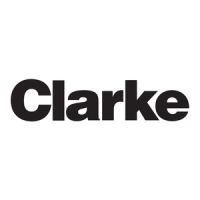34
7. Cooling System
Engine Operating Temperature
The C18 engines are provided with either a heat exchanger or radiator to maintain the engine coolant
temperature within recommended operating guidelines.
Intended Engine Operating Temperature
The C18 models have an intended engine operating temperature of 190º F (88ºC) to 205º F (96º C).
High Coolant Temperature Alarm
A high coolant temperature sensor monitors coolant temperature and will set an alarm at 217º F (103º C).
Heat Exchanger
C18 Engines were built with either a non-serviceable brazed heat exchanger or NSR heat exchanger.
Brazed heat exchanger (reference figure #7-1)
NSR heat exchanger (reference figure #7-2)
Engine Coolant
Per recommendations from the engine manufacturers, it has become necessary that engine coolants be
changed every 12 months using Clarke Coolant (part # C054129).
The only acceptable substitute is COOL-GARD II part number TY26575.
Warranty is contingent on utilizing the indicated coolant.
WARNING
A water and anti-freeze solution is required for pump installations. Premixing this solution prior to installing is
required. This prevents possible pure anti-freeze chemical reactions to block heater elements which can
burnout the element. Please see the I&O section (see Page 5) technical data section for proper cooling system
capacities of each model.
Water
Water can produce a corrosive environment in the cooling system, and the mineral content may permit scale
deposits to form on internal cooling surfaces. Therefore, inhibitors must be added to control corrosion,
cavitation, and scale deposits.
Chlorides, sulfates, magnesium and calcium are among the materials which make up dissolved solids that may
cause scale deposits, sludge deposits, corrosion or a combination of these. Chlorides and/or sulfates tend to
accelerate corrosion, while hardness (percentage of magnesium and calcium salts broadly classified as
carbonates) causes deposits of scale. Water within the limits specified in Figure #22 is satisfactory with an
engine coolant when properly inhibited. Use of deionized or red distilled water is preferred.

